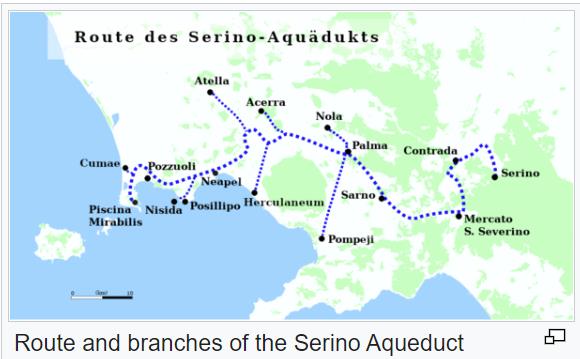"Pompeii" by Robert Harris.
Choosing notes
Chris was attracted to this by looking at some BBC iPlayer programmes which included a recommendation for Robert Harris’s writing.
We bought Pompeii and thoroughly enjoyed it.
The quality of the writing was immediately apparent; the content beyond the story was quite intriguing.
We also then read a few others and discovered that “Enigma” had been reviewed by AABC back in January 2013.
Major themes
- Water and the bay of Naples, the Aqua Augusta
- The failure of the Aqua Augusta
- The build-up to and action of a volcanic eruption
- Roman culture including slavery, orgies, technology (concrete) and water engineering
Water and the bay of Naples, the Aqua Augusta
The Aqua Augusta is a massive piece of engineering taking water over 60 miles or more from springs near the Italian town of Serino 376 Metres above sea level,
past Mt. Vesuvius,
and distributing the water to several towns including Pompeii, Nola, Acerrae, Atella, Naples, Cumae, Baiae, and terminating in the Piscina Mirabilis at Cape Misenum.
Various rich Romans also had private links to the Aqua Augusta.

The aquaduct had a gradient of 2 inches per 100 yards.
The Plot
The story is told over the period of three days prior to the eruption of Mt. Vesuvius which destroyed the towns of Pompeii and Herculaneum.
In spite of the story having such a well-known ending, the pace and tension are maintained throughout.
The Characters
The engineer in charge of an aqueduct is know as an aquarius, in this case aquarius Attilius; he interacts with Numerius Ampliatus.
Ampliatus is an emancipated Roman slave who became rich; his daughter, Corelia, Corax a worker, and Pliny the Elder are the main characters.
The writing.
Is cleverly constructed to integrate Roman culture, inter-personal tension, intrigue and a potential love story.
The tension is maintained throughout by:
- Using day and time stamps on the chapters
- Adding in quotations from works on vulcanology on each chapter
- By Pliny’s accurate observations which we understand but he doesn’t
- By the age-old conflict between leaders and workers (Attilius – Corax)
- By the love story, Attilius and Corelia
- By the pacing of dialogue (e.g. Pliny threatens to imprison Attilius, Attilius responds by asking for a trireme and resources in Pompeii
The writing includes many references to Roman culture, the depictions of an orgy and many references to sex organs become somewhat revolting.
However, the story line of the young Attilius overcoming the problems he is faced with as the “new Aquarius in charge” transcends the daily details.
Overall
The story is well paced, has lots of action, a huge amount of Roman culture, and lots of inter-personal action amongst a good variety of characters.
Book Club comments:
Almost all members of the club enjoyed this book with just one member describing the story as “pants”, feeling impatient with the detail, and not caring for the characters.
Most members found the insight into Roman engineering and culture fascinating and enjoyed the blend of historical and factual versus imaginative content.
The Attilius character was generally appreciated as a self-effacing, young, focused engineer.
The declaration of his loss of his wife was interpreted as the author setting the scene for him to be totally focused on the job in hand.
A discussion emerged around the inclusion of swearing in the dialogue; is this an un-necessary distraction, and / or an accurate depiction of male working culture.
AA Book Club rating: 4.2
If you want more:
|

